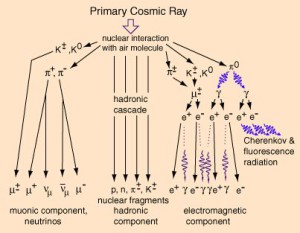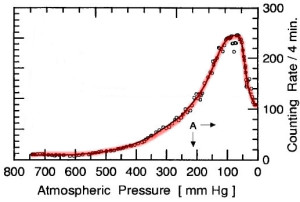The earth is permanently exposed to a flux of high energetic particles. These so called cosmic rays originate from the sun, the edge of the heliosphere as well as from outside the solar system. The primary cosmic rays consist of 90 % Protons,
% He-
and a small amount of heavier nuclei. Since charged particles undergo deflection by earth’s magnetic field, a maximum of intensity is found in polar regions which makes Kiruna an ideal place for experiments concerning cosmic rays.
When the primary cosmic rays traverse the atmosphere, the closer they approach earth surface, the more increases the density of air molecules. The resulting collisions lead to spallation of the atoms in the air and to creation of new particles. These secondary particles may then decay into a muonic or an electromagnet component or repeat this process in a hadronic cascade. Depending on the initial energy of the primary particle a high number of secondary particles can be produced in such an air shower.
As the primary component in the overall flux decreases with atmospheric depth whereas the secondary increases. This results in a maximum of the intensity at an altitude of around 20km, the so called Pfotzer Maximum. Besides the dependency on energy, latitude and altitude, there is an angular dependency as well. A minor variation can be observed in respect to the azimuthal angle , showing that the intensity slightly increases in western direction.
However, the most significant variation can be found in respect to the zenith angle . Experiments have shown that the muonic component varys with
on sea level. in general, it is assumed that, neglecting
, a function of the intensity of a component
can be given as:
All of the three in the picture introduced components include charged particles which can be measured by silicon detectors. Once a charged particle enters the sensitive volume of the detector, the deposited energy induces the ionization and excitation of the material. The resulting current can then be amplified and read out.


